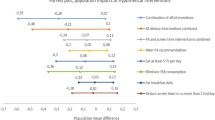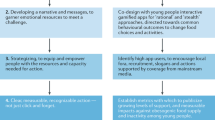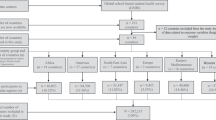Abstract
Objective:
This longitudinal study aimed to investigate the characteristics and predictive risk factors of overweight among adolescents. The hypothesis was that baseline overweight predicted most overweight over time compared to other factors, especially excessive internet use.
Subjects:
A sample of 621 youths were followed from age 14 (T0 Spring 2012) to age 16 (T1 Spring 2014) in Switzerland. Participants were divided into two groups according to their weight at the final assessment: overweight and non-overweight. At T0, participants reported demographic, health, substance use and internet use data. A logistic regression was performed to assess the explanatory variables of overweight at T1. Data are presented as adjusted odds ratios (aORs) with 95% confidence interval.
Results:
The 2-year evolution showed a net BMI increase of 4.8%. Overweight adolescents were significantly more likely to be male, to live in an urban area, to be on a diet and to report using the internet more than 2 h per day on weekends at T0. However, with the addition of baseline overweight, only the excessive use of internet on weekends remained as an explanatory variable. An adolescent who was already overweight at T0 had a more than 20-fold risk (aOR 21.04) of being overweight 2 years later. Moreover, among adolescents becoming overweight between T0 and T1, internet use did not show any significant effect.
Conclusion:
The risk of being overweight is mostly influenced by weight status at baseline compared to excessive internet use. Thus, our results do not confirm the negative effect of internet on healthier activities. Internet use could at most reinforce an already existing risk of being overweight.
This is a preview of subscription content, access via your institution
Access options
Subscribe to this journal
Receive 12 print issues and online access
$259.00 per year
only $21.58 per issue
Buy this article
- Purchase on Springer Link
- Instant access to full article PDF
Prices may be subject to local taxes which are calculated during checkout
Similar content being viewed by others
References
World Health Organization Population-based Approaches to Childhood Obesity Prevention. World Health Organization: Geneva, 2012.
World Health Organization Global Status Report on Noncommunicable Diseases 2010. World Health Organization: Geneva, 2011.
Lobstein T, Baur L, Uauy R . Obesity in children and young people: a crisis in public health. Obes Rev 2004; 5: 4–85.
Fonseca H, Matos MG, Guerra A, Gomes-Pedro J . How much does overweight impact the adolescent developmental process? Child Care Health Dev 2011; 37: 135–142.
Fonseca H, Matos MG, Guerra A, Gomes-Pedro J . Are overweight and obese adolescents different from their peers? Int J Pediatr Obes 2009; 4: 166–174.
Stamm H, Gebert A, Guggenbuhl L, Lamprecht M . Excess weight among children and adolescents in Switzerland—prevalence and correlates for the early 2010s. Swiss Med Wkly 2014; 144: w13956.
Laurson KR, Eisenmann JC, Welk GJ, Wickel EE, Gentile DA, Walsh DA . Combined influence of physical activity and screen time recommendations on childhood overweight. J Pediatr 2008; 153: 209–214.
Berkey CS, Rockett HRH, Colditz GA . Weight gain in older adolescent females: the internet, sleep, coffee, and alcohol. J Pediatr 2008; 153: 635–639.e1.
Miller SA, Taveras EM, Rifas-Shiman SL, Gillman MW . Association between television viewing and poor diet quality in young children. Int J Pediatr Obes 2008; 3: 168–176.
Mitchell JA, Rodriguez D, Schmitz KH, Audrain-McGovern J . Greater screen time is associated with adolescent obesity: a longitudinal study of the BMI distribution from Ages 14 to 18. Obesity 2013; 21: 572–575.
Canan F, Yildirim O, Ustunel TY, Sinani G, Kaleli AH, Gunes C et al. The relationship between internet addiction and body mass index in Turkish adolescents. Cyberpsychol Behav Soc Netw 2014; 17: 40–45.
Mitchell JA, Pate RR, Beets MW, Nader PR . Time spent in sedentary behavior and changes in childhood BMI: a longitudinal study from ages 9 to 15 years. Int J Obes (Lond) 2013; 37: 54–60.
Mitchell JA, Pate RR, Espana-Romero V, O'Neill JR, Dowda M, Nader PR . Moderate-to-vigorous physical activity is associated with decreases in body mass index from ages 9 to 15 years. Obesity 2013; 21: E280–E293.
Anderson DR, Huston AC, Schmitt KL, Linebarger DL, Wright JC . Early childhood television viewing and adolescent behavior: the recontact study. Monogr Soc Res Child Dev 2001; 66: I–VIII 1–147.
Metcalf BS, Hosking J, Jeffery AN, Voss LD, Henley W, Wilkin TJ . Fatness leads to inactivity, but inactivity does not lead to fatness: a longitudinal study in children (EarlyBird 45). Arch Dis Child 2011; 96: 942–947.
Melkevik O, Torsheim T, Iannotti RJ, Wold B . Is spending time in screen-based sedentary behaviors associated with less physical activity: a cross national investigation. Int J Behav Nutr Phys Act 2010; 7: 46.
Hands BP, Chivers PT, Parker HE, Beilin L, Kendall G, Larkin D . The associations between physical activity, screen time and weight from 6 to 14 yrs: the Raine Study. J Sci Med Sport 2011; 14: 397–403.
Fakhouri TI, Hughes JP, Brody DJ, Kit BK, Ogden CL . PHysical activity and screen-time viewing among elementary school–aged children in the united states from 2009 to 2010. JAMA Pediatr 2013; 167: 223–229.
Marshall SJ, Biddle SJH, Gorely T, Cameron N, Murdey I . Relationships between media use, body fatness and physical activity in children and youth: a meta-analysis. Int J Obes Relat Metab Disord 2004; 28: 1238–1246.
Kim Y, Park JY, Kim SB, Jung IK, Lim YS, Kim JH . The effects of internet addiction on the lifestyle and dietary behavior of Korean adolescents. Nutr Res Pract 2010; 4: 51–57.
Leatherdale ST, Wong S . Association between sedentary behavior, physical activity, and obesity: inactivity among active kids. Prev Chronic Dis 2009; 6: A26.
Suris J-C, Michaud P-A, Chossis I, Jeannin A . Towards a sedentary society: trends in adolescent sport practice in Switzerland (1993–2002). J Adolesc Health 2006; 39: 132–134.
Sallis JF . Age-related decline in physical activity: a synthesis of human and animal studies. Med Sci Sports Exerc 2000; 32: 1598–1600.
Krebs NF, Himes JH, Jacobson D, Nicklas TA, Guilday P, Styne D . Assessment of child and adolescent overweight and obesity. Pediatrics 2007; 120 (Supplement 4): S193–S228.
Maes HHM, Neale MC, Eaves LJ . Genetic and environmental factors in relative body weight and human adiposity. Behav Genet 1997; 27: 325–351.
Cole TJ, Bellizzi MC, Flegal KM, Dietz WH . Establishing a standard definition for child overweight and obesity worldwide: international survey. BMJ 2000; 320: 1240–1243.
Hibell B, Andersson B, Bjarnason T, Ahlström S, Balakireva O, Kokkevi A et al The ESPAD Report 2003: Alcohol and Other Drug Use Among Students in 35 European Countries. The Swedish Council for Information on Alcohol and Other Drugs: Sweden, 2003.
Mejia D, Berchtold A, Belanger RE, Kuntsche EN, Michaud PA, Suris JC . Frequency and effects of meeting health behaviour guidelines among adolescents. Eur J Public Health 2013; 23: 8–13.
World Health Organization Wellbeing Measures in Primary Health Care: The Depcare Project. World Health Organization, Regional Office for Europe: Copenhagen, 1998.
Storfer-Isser A, Patel SR, Babineau DC, Redline S . Relation between sleep duration and BMI varies by age and sex in youth age 8–19. Pediatr Obes 2012; 7: 53–64.
Farhat T, Iannotti RJ, Simons-Morton BG . Overweight, obesity, youth, and health-risk behaviors. Am J Prev Med 2010; 38: 258–267.
Penzes M, Czegledi E, Balazs P, Foley KL . Factors associated with tobacco smoking and the belief about weight control effect of smoking among Hungarian adolescents. Cent Eur J Public Health 2012; 20: 11–17.
Michaud PA, Suris JC, Deppen A . Gender-related psychological and behavioural correlates of pubertal timing in a national sample of Swiss adolescents. Mol Cell Endocrinol 2006; 254–255: 172–178.
Carlson SA, Fulton JE, Lee SM, Foley JT, Heitzler C, Huhman M . Influence of limit-setting and participation in physical activity on youth screen time. Pediatrics 2010; 126: e89–e96.
Young KS . Internet addiction: the emergence of a new clinical disorder. Cyberpsychol Behav 1998; 1: 237–244.
Khazaal Y, Billieux J, Thorens G, Khan R, Louati Y, Scarlatti E et al. French validation of the internet addiction test. Cyberpsychol Behav 2008; 11: 703–706.
Lopes AS, Silva KS, Barbosa Filho VC, Bezerra J, de Oliveira ES, Nahas MV . Trends in screen time on week and weekend days in a representative sample of Southern Brazil students. J Public Health (Oxf) 2014; 36: 608–614.
Bucksch J, Inchley J, Hamrik Z, Finne E, Kolip P . Trends in television time, non-gaming PC use and moderate-to-vigorous physical activity among German adolescents 2002–2010. BMC Public Health 2014; 14: 351.
Acknowledgements
The ado@internet.ch study has been financed by the Service of Public Health of the canton of Vaud and by the Swiss National Science Foundation (FNS 105319_140354).
Author information
Authors and Affiliations
Corresponding author
Ethics declarations
Competing interests
The authors declare no conflict of interest.
Rights and permissions
About this article
Cite this article
Barrense-Dias, Y., Berchtold, A., Akre, C. et al. The relation between internet use and overweight among adolescents: a longitudinal study in Switzerland. Int J Obes 40, 45–50 (2016). https://doi.org/10.1038/ijo.2015.146
Received:
Revised:
Accepted:
Published:
Issue Date:
DOI: https://doi.org/10.1038/ijo.2015.146
This article is cited by
-
Association between age of first exposure and heavy internet use in a representative sample of 317,443 adolescents from 52 countries
European Child & Adolescent Psychiatry (2023)
-
The impact of healthy lifestyles on academic achievement among Italian adolescents
Current Psychology (2023)
-
A collaborative approach to adopting/adapting guidelines. The Australian 24-hour movement guidelines for children (5-12 years) and young people (13-17 years): An integration of physical activity, sedentary behaviour, and sleep
International Journal of Behavioral Nutrition and Physical Activity (2022)



